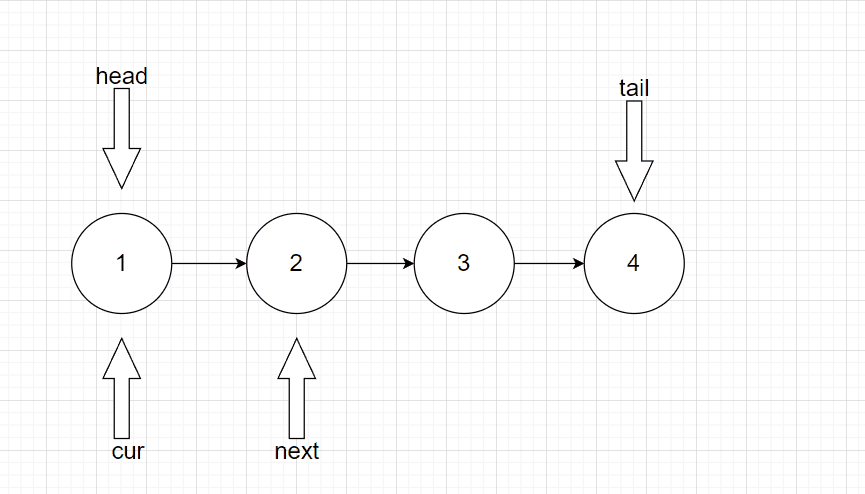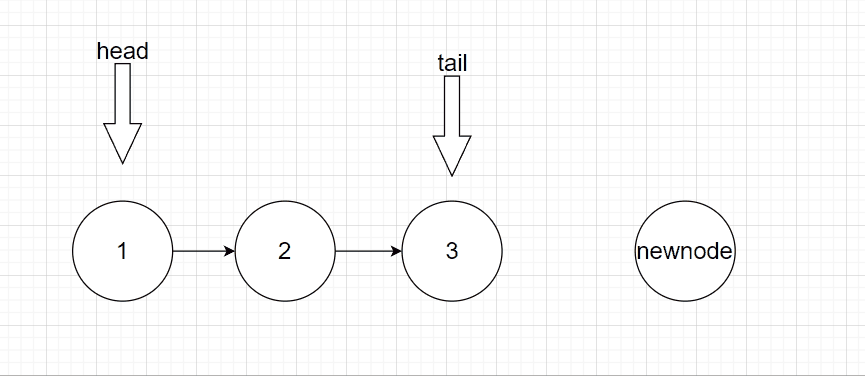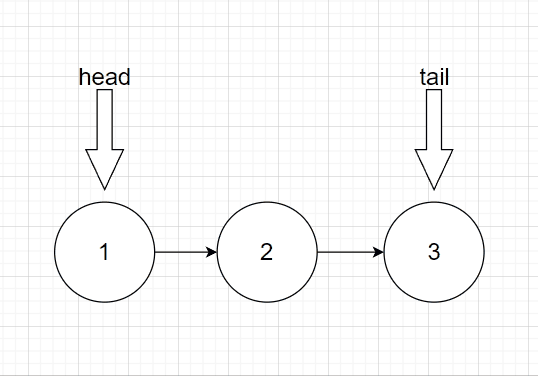这篇文章主要介绍了C语言如何实现队列的相关知识,内容详细易懂,操作简单快捷,具有一定借鉴价值,相信大家阅读完这篇C语言如何实现队列文章都会有所收获,下面我们一起来看看吧。
队列是一种特殊的线性表,特殊之处在于它只允许在表的前端(head)进行删除操作,而在表的后端(tail)进行插入操作,和栈一样,队列是一种操作受限制的线性表。进行插入操作的端称为队尾,进行删除操作的端称为队头。
这个队列就可以理解成我们平时的排队,先进入的先出去,与我们之前实现的先进后出的栈相反。
再把上次的图拿出来,我们看看是用线性表来实现队列,还是链表比较好
| 不同点 | 顺序表 | 链表 |
|---|---|---|
| 存储空间上 | 物理上一定连续 | 逻辑上连续,但物理上不一定连续 |
| 随机访问 | 可以直接访问任何元素 | 必须从头节点开始往后寻找 |
| 任意位置插入或删除元素 | 要搬移其他的元素,效率低。 | 只需要修改节点的指针指向,效率高 |
| 插入 | 动态顺序表,当空间不够时需要扩容 | 无容量概念,需要就申请,不用就释放 |
| 应用场景 | 元素高效存储,并且需要频繁访问 | 需要在任意位置插入或者删除频繁 |
综合上表来看,我觉得链表较为方便,原因如下:
1.队列有多少元素不确定,链表可以做到需要就申请,不用就释放,较为方便
2.队列是先进先出,顺序固定,不需要随机访问。
1.包含的标准库
#include <stdio.h>
#include <stdlib.h>
#include <stdbool.h>
#include <assert.h>2.定义结构体
typedef int QDateType;//队列存储数据类型
typedef struct QueueNode //队列元素节点
{
QDateType val;
struct QueueNode* next;
}QueueNode;
typedef struct Queue //队列
{
QueueNode* head;
QueueNode* tail;
}Queue;3.函数声明
void QueueInti(Queue* pq);
// 队列初始化
void QueueDestory(Queue* pq);
// 队列的销毁
void QueuePush(Queue* pq, QDateType x);
// 入队
void QueuePop(Queue* pq);
// 出队
QDateType QueueFront(Queue* pq);
// 取出队首元素
int QueueSize(Queue* pq);
// 求队列的长度
bool QueueEmpty(Queue* pq);
// 判断队是否为空1.队列的初始化
将头尾置为空指针即可。
void QueueInti(Queue* pq)
{
assert(pq); //防止pq为空指针
pq->head = pq->tail = NULL;
}2.队列的销毁
遍历队列元素,然后将每一个元素释放。
void QueueDestory(Queue* pq)
{
assert(pq); //防止pq为空指针
QueueNode* cur = pq->head;
while (cur)
{
QueueNode* next = cur->next;
free(cur);
cur = next;
}
pq->tail = pq->head = NULL;
}
3.入队
对于入队,我们首先需要去开辟一个新的节点来存储数据,然后将这个节点加入到tail后即可。此时我们就要分别考虑。
1.如果为空队列,那么我们不仅要改变tail,还要改变head的值
2.如果不为空队列,只用改变tail即可。
void QueuePush(Queue* pq, QDateType x)
{
assert(pq); //防止pq为空指针
QueueNode* newNode = (QueueNode*)malloc(sizeof(QueueNode));
if (NULL == newNode)
{
printf("malloc error\n");
exit(-1);
}
newNode->val = x;
newNode->next = NULL;//开辟一个新节点存储数据
if (pq->tail == NULL)//判断是否为空队列
{
assert(pq->head == NULL);
pq->head = pq->tail = newNode;
}
else
{
pq->tail->next = newNode;
pq->tail = newNode;
}
}
4.出队
对于出队,我们同样需要考虑两种情况
队列为空,改变head的同时改变tail
队列不为空,改变head即可。
void QueuePop(Queue* pq)
{
assert(pq);//防止pq为空指针
assert(pq->head && pq->tail); //防止队列为空队列
if (pq->head->next == NULL)
{
free(pq->head);
pq->head = pq->tail = NULL;
}
else
{
QueueNode* next = pq->head->next;
free(pq->head);
pq->head = next;
}
}
5. 取出队首元素
没啥说的,直接访问头节点取出即可
QDateType QueueFront(Queue* pq)
{
assert(pq);//防止pq为空指针
assert(pq->head && pq->tail); //防止队列为空队列
return pq->head->val;
}6.判断是否为空队列
我们只需要判断头指针是否为NULL,如果是则为空
bool QueueEmpty(Queue* pq)
{
assert(pq);
return pq->head == NULL;
}7. 求队伍长度
创建一个变量,遍历队伍求长度。
int QueueSize(Queue* pq)
{
assert(pq);
QueueNode* cur = pq->head;
int count = 0;
while (cur)
{
cur = cur->next;
count++;
}
return count;
}#include <stdio.h>
#include <stdlib.h>
#include <stdbool.h>
#include <assert.h>
typedef int QDateType;
typedef struct QueueNode
{
QDateType val;
struct QueueNode* next;
}QueueNode;
typedef struct Queue
{
QueueNode* head;
QueueNode* tail;
}Queue;
void QueueInti(Queue* pq)
{
assert(pq);
pq->head = pq->tail = NULL;
}
void QueueDestory(Queue* pq)
{
assert(pq);
QueueNode* cur = pq->head;
while (cur)
{
QueueNode* next = cur->next;
free(cur);
cur = next;
}
pq->tail = pq->head = NULL;
}
void QueuePush(Queue* pq, QDateType x)
{
assert(pq);
QueueNode* newNode = (QueueNode*)malloc(sizeof(QueueNode));
if (NULL == newNode)
{
printf("malloc error\n");
exit(-1);
}
newNode->val = x;
newNode->next = NULL;
if (pq->tail == NULL)
{
assert(pq->head == NULL);
pq->head = pq->tail = newNode;
}
else
{
pq->tail->next = newNode;
pq->tail = newNode;
}
}
void QueuePop(Queue* pq)
{
assert(pq);
assert(pq->head && pq->tail);
if (pq->head->next == NULL)
{
free(pq->head);
pq->head = pq->tail = NULL;
}
else
{
QueueNode* next = pq->head->next;
free(pq->head);
pq->head = next;
}
}
bool QueueEmpty(Queue* pq)
{
assert(pq);
return pq->head == NULL;
}
QDateType QueueFront(Queue* pq)
{
assert(pq);
assert(pq->head);
return pq->head->val;
}
int QueueSize(Queue* pq)
{
assert(pq);
QueueNode* cur = pq->head;
int count = 0;
while (cur)
{
cur = cur->next;
count++;
}
return count;
}关于“C语言如何实现队列”这篇文章的内容就介绍到这里,感谢各位的阅读!相信大家对“C语言如何实现队列”知识都有一定的了解,大家如果还想学习更多知识,欢迎关注亿速云行业资讯频道。
亿速云「云服务器」,即开即用、新一代英特尔至强铂金CPU、三副本存储NVMe SSD云盘,价格低至29元/月。点击查看>>
免责声明:本站发布的内容(图片、视频和文字)以原创、转载和分享为主,文章观点不代表本网站立场,如果涉及侵权请联系站长邮箱:is@yisu.com进行举报,并提供相关证据,一经查实,将立刻删除涉嫌侵权内容。